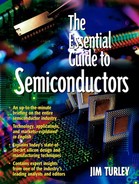Choosing Microprocessors
The market for microprocessors is enormously competitive. Well over 100 different 32-bit microprocessors are available, with even more 16-bit, 8-bit, and 4-bit chips competing for the low end. In all, about 1,000 different processors are competing over millions of different systems, from thermostats to thermonuclear weapons.
Paradoxically, this most technical of products competes on very nontechnical grounds. At the high end of the market, perception and advertising have a big influence on buying decisions and market success. The ultimate example is PC processors: Television advertisements urge (presumably) nontechnical viewers to buy a product they don't understand. The ads don't contain even a hint of technical material. They're all about image and brand-name recognition. When information fails, image prevails.
The 32-bit embedded microprocessor market is only a little less image-conscious. Processor families like MIPS and ARM are successful because they're perceived as safe choices, used and adopted by dozens of clients with no apparent complaints. Even though many other 32-bit alternatives exist, some of which might even be technically superior, their advantages aren't always compelling enough to break through the image of the market leaders.
Software Compatibility
Most of all, the microprocessor business is determined by software. Most buyers choose a microprocessor not by the merits of its hardware, but by the advantages of its software. Because every microprocessor family has its own special instruction set, and programs written for one microprocessor family cannot run on another, it follows that choosing a microprocessor also means choosing the software that's available for it. For most buyers, that's putting the cart before the horse. They'd rather decide what software they want, and then choose a microprocessor that works with that software.
Choosing a microprocessor is a bit like choosing a new language to study. Any new language requires about the same amount of effort to master, so you generally choose one that's widely used (Spanish, French, or Mandarin), one that's related to your area of interest (Italian for singers), or one that's locally popular (German in Milwaukee or Vietnamese in San Jose). The choice has nothing to do with the expressive power of the language or its other qualities; it has more to do with its place in the outside world. Similarly, buyers choose microprocessors that are in wide use, suited to their applications, or entrenched within their company or industry. This has little to do with bittedness, architecture, or any other intrinsic qualities of the hardware.
The downside of this herd instinct is that it makes it harder to differentiate a new product. If you've chosen a particular microprocessor because others in your industry have done so, you're no different from your competitors. You've gained a software foundation but lost a hardware advantage. In the worst case, you differentiate your product by the color of its plastic (literally true in some cases). More optimistically, you can create new software for the product that's original. The additional software can add features your competitors don't have, masking the underlying similarities in the hardware.
